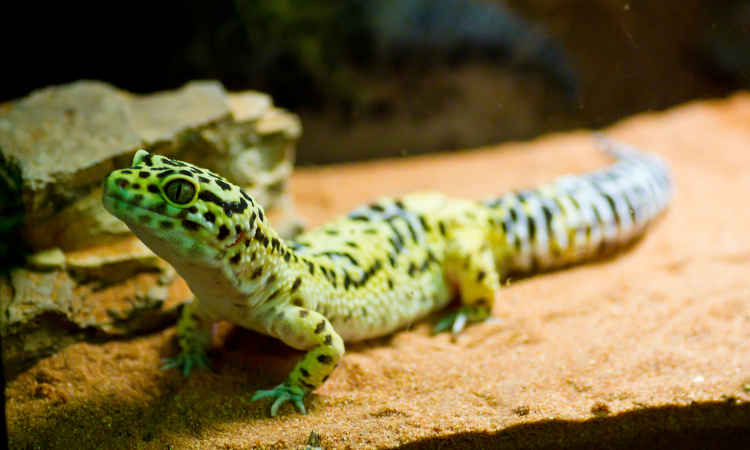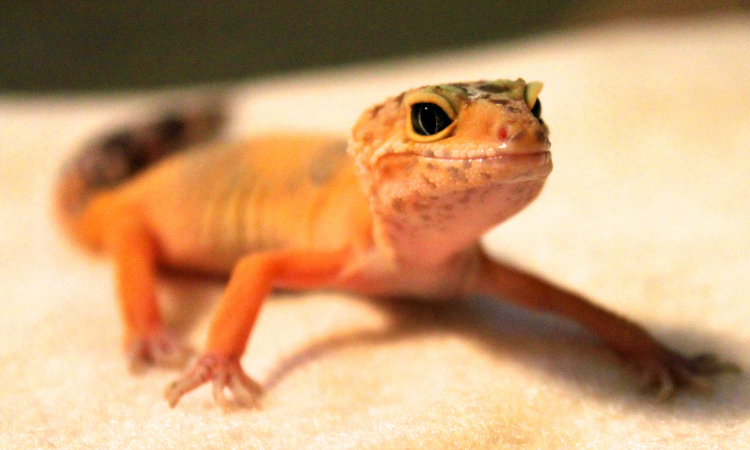Do you own a leopard gecko and have ever wondered why it sleeps all day and crawls around your home at night? If so, you’ve likely discovered that while some reptiles are predominantly active during the day, others such as Leopard Geckos tend to be mainly nocturnal.
Whether you’re wondering if your pet should stay up later or where their nighttime roaming comes from, understanding their natural habits can help make living with them easier – read on to learn more about the nocturnal lifestyle of leopard geckos!

Understanding the Natural Habits of Leopard Geckos
Unveiling the hidden world of the leopard gecko is a fascinating journey that gives us a glimpse into the lives and natural habits of these captivating creatures. Their origin can be traced back to the arid deserts and rocky grasslands of Asia and the Middle East, where the leopard geckos have mastered the art of adaptation to thrive in such extreme conditions.
Their distinct nocturnal lifestyles offer a peek into their intriguing hunting routines, as their rapidly moving eyes allow them to accurately detect scurrying insects even in the low light conditions to satiate their appetites.
Like an artist painting on their canvas, these magnificent reptiles participate in a mysterious skin-shedding ritual, consuming their old layer to reveal a vibrant new one while gaining valuable nutrients in the process.
One can truly appreciate the intricacies and beauty of nature’s design by understanding the natural habits of leopard geckos.
Factors that Determine How Active a Leopard Gecko is During the Day
The activity level of a leopard gecko during the day relies heavily on a variety of factors that have a significant impact on their energy, mood, and overall well-being. These lively creatures are often regarded for their striking patterns and colors, but what truly piques the curiosity of their caregivers is what exactly drives their diurnal activity levels.
One influential factor includes the environment, where factors such as temperature, humidity, and light can play a pivotal role in how much the gecko explores and moves around. Proper enrichment within their habitat, including hiding spots and items for climbing, also affects the stimulation and overall activity of the gecko.
Furthermore, the health and age of the leopard gecko can directly affect their enthusiasm during the day, as younger geckos tend to exhibit a higher energy level.
Taking all these factors into consideration, one can better understand and optimize the care of their leopard gecko, ensuring an active and fascinating day-to-day experience for both pet and owner alike.
Creating an Environment Where a Leopard Gecko Can Be Active During the Day
Establishing an environment where a leopard gecko can be active during the day requires attention to detail, as these fascinating creatures are naturally more active during dusk and dawn. Creating a vivarium that mimics their natural habitat can encourage them to be more lively during daylight hours.
To accomplish this, provide ample hiding spaces, such as logs, caves, and leafy plants where they can feel safe and secure. Next, regulate the temperature within the enclosure to ensure it stays warm enough, between 88-92°F on the warm side and 75-80°F on the cool side. Offering a gentle gradient of light intensity throughout the day, with the help of a timer, can also help leopard geckos adjust to the daytime schedule.
Additionally, engaging with your gecko with both mental and physical stimuli, such as rearranging their habitat or introducing toys, will offer enrichment and help nurture their curiosity, further enticing them to be more active during the day.

Diet and Feeding Habits of Leopard Geckos at Night
As the darkness falls and the night comes alive, the captivating diet and feeding habits of the enigmatic leopard geckos take center stage. These nocturnal reptiles rely on their finely tuned senses to navigate their surroundings in low-light conditions, seeking out various insects and spiders to satisfy their voracious appetites.
The cunning leopard geckos employ a stealthy approach, carefully stalking their prey, before launching a swift and accurate attack. The result? A fascinating natural spectacle for pet owners and reptile enthusiasts alike.
By carefully studying the nocturnal eating habits of these geckos, it becomes apparent that for them, the night is not just a time to rest but one to explore a fantastical world full of enticing prey, making it the ultimate hunting ground for these tiny carnivorous creatures.
Things to Consider When Deciding if a Leopard Gecko Should Be Kept in a Nocturnal or Diurnal Environment
As you contemplate whether to maintain a nocturnal or diurnal environment for your leopard gecko, there are several crucial factors to bear in mind in order to ensure the creature’s comfort and well-being.
Primarily, these fascinating reptiles are naturally nocturnal animals, meaning that they are most active during the night and prefer to rest during the day. By mimicking their natural habitat, you can create an environment where your beloved gecko will thrive.
Furthermore, paying attention to temperature and lighting requirements is indispensable as leopard geckos depend on a particular range of temperature to digest their food and maintain their metabolic processes.
Creating a space with ample hiding spots for relaxation and proper heating equipment will guarantee a healthy and content gecko while also providing you with a unique opportunity to observe their captivating behaviors during their most active period.

Ways to Help Keep Your Pet Healthy Regardless of Their Activity Cycle
Having a healthy and happy pet is every owner’s ultimate goal, regardless of whether your beloved furry friend is a couch potato or an energetic explorer. A key aspect to ensuring their well-being starts with providing them with a nutritional and balanced diet tailored to their specific needs.
This not only shapes their eating habits, but also helps in maintaining an ideal body weight, which is vital for their overall health. Regular check-ups and engaging communication with your veterinarian can help you in monitoring any changes in their health and obtaining prompt guidance for their care.
Additionally, carving out a dedicated schedule for physical and mental exercises contributes enormously to their well-being, regardless of their activity level. This can range from participating in interactive indoor games or going for leisurely walks around the neighborhood.
Lastly, don’t forget the importance of showering your pet with love, patience, and attention. A strong bond with your pet can make a world of difference in helping them navigate an active or low-energy lifestyle while retaining their health and happiness.
Overall, keeping a leopard gecko can be beneficial but also requires understanding of the pet’s natural habits. Leopard geckos are nocturnal by nature and typically sleep during the day, though factors such as temperature, season, and lighting can impact their activity level.
It is important to create an environment that allows leopard geckos to adjust their activity levels naturally while still staying active during the day. Their diet should also be taken into account when considering the best environment in which to keep them.
When it comes to deciding whether your pet should be kept in a nocturnal or diurnal environment, several factors must be taken into consideration such as temperature and humidity levels.
With these things in mind, you can help ensure that your leopard gecko stays healthy and happy regardless of its activity cycle.

Hi – I’m Erika, the lead gecko enthusiast here at Geckopedia! I write articles about pet geckos, including what to feed your leopard gecko and how to help your pet gecko live a long, happy life! I graduated with advanced degrees from UC-Berkeley, the University of Southern California (USC) and Indiana University-Bloomington, where I studied Biology and Animal Science. I use my experience to help others learn about gecko care, and I am an advocate for all topics gecko related!
